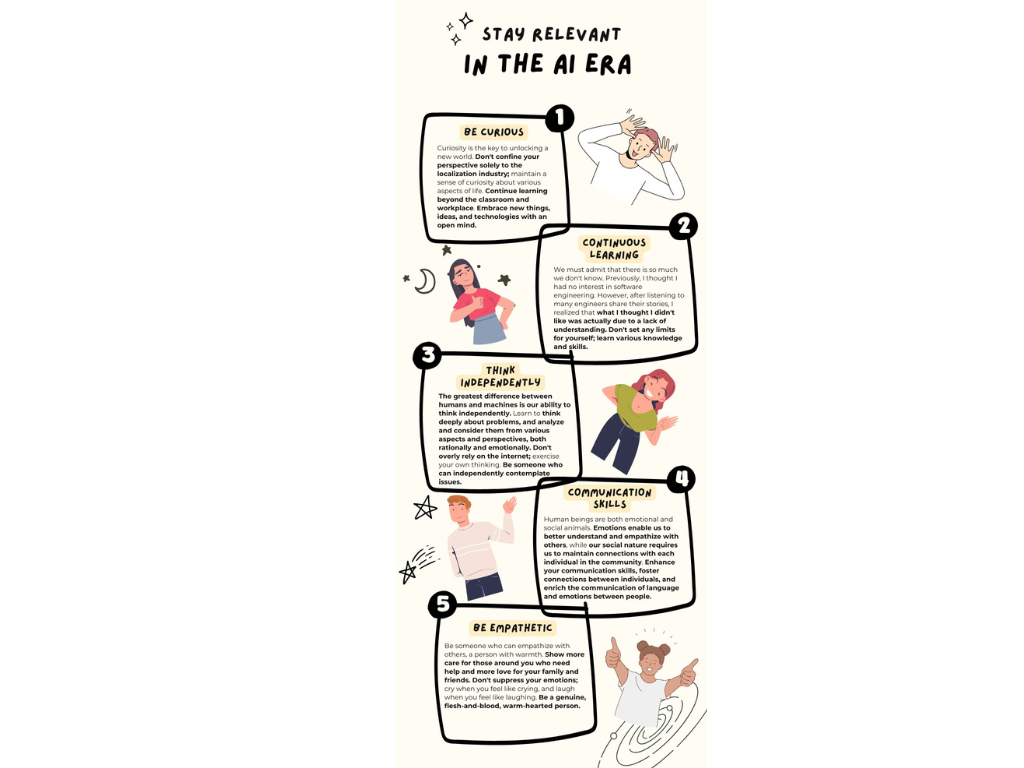- Home
- Resource Center
- Articles & Videos
- In the Era of AI: Navigating the Path Ahead with Creativity and Purpose
11 June 2024
In the Era of AI: Navigating the Path Ahead with Creativity and Purpose

This article is a runner-up submission for the 2024 Rising Star Scholarship. It explores the impact of AI on education and the global language industry.
From being a topic seldom mentioned, to appearing in science fiction novels, and now becoming the subject of widespread discussion, AI has swiftly, directly, and comprehensively marched into our lives.
After all, in the not-so-distant past, the idea of artificial intelligence was just a concept woven into the fabric of our imagination. Fast forward to today, and AI has burst forth from the pages of speculative fiction, embedding itself seamlessly into the tapestry of our daily lives. This technological revolution has ushered in an era of unparalleled change.
In my 23 years of life, I have witnessed numerous changes. Countless experiences have taught me that when facing a colossal shift in an era, what we can do is discover the value within the changes and steady the helm amidst the waves of the change, navigating smoothly. Today, I would like to analyze with you the impact of AI on the fields of education and language, and how we can embrace these changes.
The Benefits of AI
1. Enhancing personalized support for teachers at scale
The lack of communication between teachers and students is one of the reasons why a good education is difficult to achieve. The lack of channels for students to give feedback on their suggestions and the lack of ways for teachers to hear the voices and needs of students are problems faced by countless schools.
However, the advent of the AI era has effectively solved the problem of communication between teachers and students.
• Real-time feedback and suggestions: AI-powered observation tools can record and analyze classroom activities in real time. These tools can track teacher-student interactions, engagement levels, and overall classroom dynamics, providing valuable insights for improvement. AI-driven speech recognition tools can analyze classroom discussions, identifying patterns in teacher and student dialogue. This can help in assessing the effectiveness of communication strategies, question styles, and overall engagement. AI- driven chatbots can be integrated into virtual learning environments or communication platforms.Students can provide feedback or ask questions to the chatbot, which can then offer instant suggestions or forward relevant concerns to the teacher. Dora Demszky, assistant professor of education data science, highlighted the ability of AI to provide real-time feedback and suggestions to teachers (e.g., questions to ask the class), creating a bank of live advice based on expert pedagogy.
• Post-teaching feedback: Demszky added that AI can produce post-lesson reports summarizing classroom dynamics. Potential metrics include student speaking time or identification of the questions that triggered the most engagement. Research finds that when students talk more, learning is improved. AI-powered survey tools can automatically generate post-teaching feedback forms. Teachers can customize these forms to collect specific insights, and AI algorithms can analyze the responses, providing a comprehensive overview of the class's perceptions and experiences. AI algorithms can analyze data from learning management systems, examining metrics like student participation, assignment completion rates, and quiz scores. This information can be correlated with feedback data to provide a holistic view of teaching effectiveness.
• Simulating students: AI can generate simulated classroom scenarios, allowing teachers-in-training to practice and refine their teaching strategies. This provides a risk-free environment for educators to experiment with different approaches and learn from simulated student responses. AI-driven student simulations can respond dynamically to different teaching methods. Teachers can experiment with varied instructional techniques, and the AI simulators will react realistically, enabling educators to gauge the effectiveness of their approaches. AI simulating students can assist teachers in designing personalized learning experiences. Educators can observe how different instructional approaches impact simulated students, enabling them to tailor lesson plans to individual learning styles. Percy Liang, director of the Stanford HAI Center for Research on Foundation Models, said that they are increasingly effective and are now capable of demonstrating confusion and asking adaptive follow-up questions.

2. Changing what is important for learners
With the advancement of AI technology, we often hear statements like, "Our industry is going to be replaced by AI!" Obviously, AI can't completely replace humans, but it can change the way humans learn, work, and live.
• Professor Rob Reich from Stanford's political science department brought up a thought-provoking question: Can generative AI be likened to the ubiquitous calculator in classrooms, or might it be a more harmful tool? We're all familiar with how calculators have become a staple in middle and high schools, aiding us in swiftly tackling complex math problems. However, unlike calculators, which coexist with traditional mathematical teachings, Reich raised concerns about the potential impact of outsourcing writing tasks to AI. He argued that writing serves as a means to foster critical thinking skills. Could relying extensively on AI for writing assignments potentially hinder our development of essential critical thinking abilities? It's an intriguing question that prompts us to ponder the role of technology in shaping our cognitive skills.
• Liang put forward the idea that we should grasp the fundamentals of how the world operates from the ground up, whether it's mastering basic addition or understanding sentence structure. However, the emphasis is no longer on being entirely proficient in these tasks – we're not expected to carry out all computations by hand or write essays without any support from AI. The perspective here is more about cultivating a foundational understanding of key principles, with the acknowledgment that technology, particularly AI, can complement our skills and contribute to a more efficient and dynamic learning process. It's like striking a balance between grasping the basics and harnessing the power of AI to enhance our educational journey.
• In fact, by no longer requiring mastery of proficiency, Demszky argued that AI may actually raise the bar. The models won’t be doing the thinking for the students; rather, students will now have to edit and curate, forcing them to engage deeper than they have previously . In Khan’s view, this allows learners to become architects who are able to pursue something more creative and ambitious.
• Noah Goodman, an associate professor in both psychology and computer science at Stanford, raised an intriguing point. He questioned the comparison, suggesting that this tool—referring to generative AI—might resemble the printing press more than a mere calculator. He drew parallels to how the printing press democratized knowledge, revolutionizing access to information. Importantly, it didn't render human writing skills obsolete. In this light, Goodman's perspective prompts us to consider generative AI as a transformative force, akin to the printing press, that could enhance accessibility to information without diminishing the value of our innate writing abilities. It encourages us to view these technological advancements as catalysts for democratizing knowledge rather than replacements for our essential human skills.

3. Improving learning and assessment quality
• It's fascinating to witness how AI tools, like speech recognition and natural language processing, are breaking down barriers and making education more accessible, especially for individuals with disabilities. These innovative technologies go beyond traditional methods, offering real-time transcription and translation services. This means that those with hearing impairments can have spoken words transformed into text in real-time, aiding their comprehension.
• Additionally, individuals who speak different languages can benefit from instant translation services, creating a more inclusive and diverse educational environment. The impact of these AI tools extends far beyond the classroom, opening up new opportunities for everyone to engage in a more accessible and enriching learning experience.
• It's eye-opening to hear Bryan Brown, a professor of education, highlight the mismatch between what we know about learning and how we actually teach. Take powerful classroom discussions, for instance—teachers recognize their significance, yet the limitations of one student speaking at a time hinder the full potential of these interactions. Enter AI, with its transformative potential. It's intriguing to think about AI supporting a single teacher in generating 35 unique conversations with each student, fostering more personalized and engaging learning experiences.
• What's equally noteworthy is how this extends to the workforce. In a roundtable discussion led by Stanford Digital Economy Lab Director Erik Brynjolfsson and Candace Thille, an associate professor of education, the focus shifted to the challenge of accurately judging a learner's skill profile in the professional arena. It's remarkable to consider how AI could address this challenge, swiftly assessing a learner's skills, suggesting solutions to bridge gaps, and even aligning individuals with roles that truly demand their specific skill set. The potential of AI to bridge these gaps in both education and the workforce is indeed a thought-provoking aspect of the ongoing technological revolution.
4. Enabling learning without fear of judgment
It's intriguing to hear from Ran Liu, the chief AI scientist at Amira Learning, about the potential of AI to boost learners' self-confidence. What caught my attention is how AI interfaces can play a role in this. By providing constructive feedback without the same social stakes as human responses, AI creates a more comfortable space for learners. This, in turn, encourages students to be more open, take risks, and be vulnerable in their learning experiences.
I find this concept particularly valuable in the realm of soft skills, as highlighted by Emma Brunskill, an associate professor of computer science. Soft skills like communication, critical thinking, and problem-solving are notoriously challenging to teach effectively. With the assistance of AI, learners can engage with a real-time agent that offers support and feedback. This dynamic learning environment allows students to experiment with different tactics as they work towards improving these essential soft skills. It's fascinating to see how AI is not just a technological aid but also a catalyst for creating a more supportive and less intimidating learning atmosphere.

The disadvantages of AI
1. The model output does not reflect true cultural diversity
It's concerning to acknowledge that current AI, including ChatGPT, falls short in generating language that truly represents the diversity within the student population. The way these bots generate text doesn't capture the authentic voices of the diverse communities served by the education system. In an attempt to mimic the cadence of the author of "The Hate U Give," featuring an African American protagonist, ChatGPT added a simple "yo" in front of random sentences. This stark gap, as explained by Sarah Levine, an assistant professor of education, hinders the creation of an equitable environment that fosters connection and safety, especially for some of America's most underserved learners. It highlights the need for AI to evolve and better reflect the richness and diversity of voices within educational settings.
2. Models do not optimize for student learning
• Many AI models may not provide sufficiently personalized learning experiences. Students have diverse learning styles, preferences, and paces, and a one-size-fits-all approach may not effectively address individual needs.
• AI models may struggle to assess and optimize for soft skills such as communication, collaboration, creativity, and adaptability. These skills are crucial in real-world scenarios but may not be adequately addressed by some AI-driven educational tools.
• AI models may not be well-equipped to adapt to cultural and linguistic diversity in the student population. This can result in a lack of inclusivity and relevance in educational content, potentially hindering the learning experience for certain groups of students.
3. Incorrect responses come in pretty packages
It's both fascinating and somewhat perplexing to learn from Goodman's demonstration that AI can generate text that appears coherent and proficient while being entirely incorrect. In his lab, they undertook the ambitious task of training a virtual tutor to solve and explain algebra equations using a chatbot format. What's intriguing is that this chatbot was adept at crafting flawless sentences, showcasing high-quality teaching techniques like positive reinforcement. However, when it came down to the core of the matter— the right mathematical answer—the chatbot fell short.
This revelation underscores the complex nature of AI capabilities. It's like having a tutor who can eloquently explain concepts, and motivate you with positive words, but might stumble when it comes to the precision required in solving mathematical problems. It raises thought-provoking questions about the boundaries of AI understanding and its ability to truly grasp and apply knowledge in specific domains. As a student navigating the AI landscape, it's a reminder to approach automated assistance with a discerning eye, recognizing that proficiency in language doesn't always equate to accuracy in content.
4. Advances exacerbate a motivation crisis
The student was concerned about the rapid progress of ChatGPT and how this would deter future job prospects after many years of learning how to code. Piech connected the incident to a broader existential motivation crisis, where many students may no longer know what they should be focusing on or don’t see the value of their hard-earned skills.

AI is significantly impacting the global language industry in several ways, revolutionizing how languages are translated, understood, and utilized across various sectors. Striking a balance between leveraging AI for efficiency and preserving the nuances of language and culture is crucial for the continued positive impact of AI in the language industry.

Next, let's analyze how AI is impacting the global language industry in the following ways:
1. Content Generation
Definition of AI in content creation
Delving into the realm of AI in content creation is like stepping into a futuristic space where technology takes the reins in crafting, curating, and tailoring content effortlessly. This innovative approach involves the deployment of artificial intelligence technologies, particularly machine learning algorithms, to navigate and interpret various forms of content, be it articles, videos, or images. The magic happens when these algorithms not only understand the existing content but can also generate entirely new material based on specified criteria.

Imagine it as having a digital assistant that not only comprehends the nuances of what's already out there but can also whip up fresh, relevant content with a dash of creativity. This process opens up exciting possibilities for automating aspects of content creation, making it more dynamic and responsive to specific needs and preferences. It's like having a tech-savvy partner that collaborates with you in the creative process, leveraging the power of algorithms to transform ideas into tangible content.
Benefits of AI in content creation
• Cost-effective
The primary advantage of employing AI in content creation lies in its remarkable cost-cutting capabilities. AI-driven tools eliminate the need for hiring freelancers or full-time employees, significantly reducing expenses for businesses. These tools generate high-quality content at a fraction of the cost, offering a cost-effective solution for regular content creation needs. Furthermore, AI's ability to automate repetitive tasks not only saves time but also optimizes resource utilization, allowing businesses to allocate resources to other critical areas of operation, and enhancing overall cost-effectiveness.
• Time-efficient
AI in content creation offers the significant benefit of time savings. Utilizing AI-powered tools accelerates the content creation process compared to traditional methods. This efficiency arises from the automation of repetitive tasks, freeing up human resources to concentrate on creative aspects. AI's ability to swiftly analyze vast amounts of data, a task nearly impossible for humans, proves invaluable. This data analysis empowers content creators to understand audience interests and preferences, facilitating the creation of more resonant content. In essence, AI enhances the speed and efficiency of content creation, allowing creators more time to dedicate to producing high-quality content.
• Personalization of content
Personalization of content involves tailoring it to align with the unique needs and preferences of the target audience. AI plays a crucial role in achieving this by collecting data on audience interests and behaviors and using it to generate more relevant and engaging content. The benefits of content personalization include increased customer engagement, improved customer relationships, higher conversion rates, and enhanced customer insights. When users receive content that resonates with their interests, they are more likely to engage, fostering meaningful connections between brands and customers and potentially leading to increased customer loyalty and satisfaction.
• Ability to create high-quality content
The use of AI ensures consistency by adhering to the desired style and tone, aligning with the brand's voice and messaging. Additionally, AI contributes to content quality improvement by detecting and correcting errors in grammar, spelling, and punctuation, enhancing the brand's credibility and authority.
Furthermore, AI aids in optimizing content for SEO by identifying relevant keywords and increasing online visibility. In the fast-paced digital landscape, where standing out is crucial, AI's capacity to create top-notch, compelling, and relevant content becomes indispensable for brands
2. Translation and Localization
How AI is changing the landscape of content translation and localization
One significant change is the acceleration of the process's speed and accuracy, a departure from the historically time-consuming and expertise-intensive nature of translation. AI-powered tools bring efficiency, enabling quicker turnaround times and heightened productivity.
Moreover, AI's integration of machine learning algorithms stands out as a game-changer. These algorithms continuously enhance translation quality by learning from vast datasets. The ability to recognize patterns and understand language nuances contributes to more precise and natural-sounding translations over time.
Another noteworthy aspect is the democratization of translation and localization facilitated by AI. Its accessibility empowers businesses and individuals to effortlessly translate content into multiple languages. This not only broadens market reach but also creates novel opportunities for growth, showcasing how AI is breaking down language barriers and fostering global connectivity.

The benefits of AI-powered translation and localization
• Increased Speed and Efficiency
• Improved Accuracy - AI excels in recognizing linguistic nuances, idiomatic expressions, and cultural references, resulting in highly accurate translations.
• Cost-Effective Solutions - AI reduces costs by minimizing the reliance on human translators and localization experts, making translation and localization more budget-friendly for businesses.
• Enhanced Productivity
• Improved Customer Experiences - Localization, crucial for positive customer experiences, is streamlined with AI. Businesses can quickly adapt content for specific markets, boosting engagement and customer satisfaction.
• Greater Accessibility - AI-powered translation and localization break down language barriers, fostering greater accessibility and inclusivity in communication for both businesses and individuals.
• Scalability - AI adapts seamlessly to the needs of businesses, offering scalable solutions that are effective for companies of all sizes, from small enterprises to large corporations.
The challenges of using AI for translation and localization
• Lack of Contextual Understanding - A significant hurdle lies in ensuring AI comprehends the context of the text. The struggle to translate idioms, metaphors, and colloquialisms can result in mistranslations and inaccuracies.
• Require Quality Control - Despite advanced capabilities, AI tools still require meticulous quality control to guarantee accurate and culturally appropriate translations. This is crucial, particularly for sensitive or highly technical content.
• Ethical Considerations - Ethical considerations surface, such as the impact on human translators' job market and the imperative to ensure culturally respectful translations. Striking a balance in the ethical use of AI becomes paramount.
• Lack of Personalization - AI tools may fall short in catering to individual user or market nuances, lacking the ability to tailor translations to specific audience needs and preferences.
• Limited Language Support - Despite advancements, AI tools may not support all languages, particularly those less commonly spoken or written, posing a limitation in global language coverage.
3. Customer Support
AI is transforming customer service and relationship management significantly
- Real-time Insights - AI enables companies to gain real-time insights across all customer contact channels, enhancing their understanding of customer interactions.
- Agent Optimization - Companies can use AI to optimize agent availability, reduce wait times, and identify opportunities for proactive service delivery, enhancing overall efficiency.
- Automated Case Management - AI facilitates the automatic escalation and classification of cases, utilizing predictive analytics based on sensitivity and domain expertise.
- Chatbot Power - Chatbots, fueled by AI, can deliver knowledge through automated workflows, providing instant and efficient responses to customer inquiries.

- Personalized Services - AI enables companies to deliver personalized services anywhere, catering to individual customer needs and preferences.
- Scheduling and Routing Optimization - Complete CRM data, powered by AI, allows companies to optimize scheduling and routing, streamlining operations for improved efficiency.
AI is altering how businesses handle customer queries
AI is revolutionizing customer service by enabling departments to handle more than one query simultaneously. Unlike human agents who typically manage one call or problem at a time, AI, in various forms such as chatbots, significantly enhances efficiency. Chatbots, for instance, can address multiple queries concurrently, which is particularly beneficial for busy call centers aiming to mitigate wait times. In cases where queries surpass the chatbot's capabilities, a live representative can seamlessly intervene.
Moreover, AI leverages data to identify the most suitable representative for a customer's needs. It equips the representative with essential background information before the interaction, saving time, optimizing manpower, and enhancing the overall efficiency of issue resolution. This multifaceted approach to customer service showcases how AI is fundamentally improving the customer experience.
4. Speech Recognition
How does Speech Recognition AI work?
Speech recognition, or voice recognition, is a multi-step process involving audio accuracy and language solutions. It includes recognizing words, models, and content in the user's speech, and training the model for business accuracy. The process continues by converting audio and language into text, translating recognized audio into letters or numbers. AI then determines the meaning by analyzing frequently spoken words and their associations through predictive modeling. Lastly, it parses out commands from the rest of the speech or audio content, a step known as disambiguation.
Challenges in Working with Speech Recognition AI
Working with speech AI poses numerous challenges. The rapid and evolving nature of both technology and cloud development makes predicting the timeline for building a speech-enabled product difficult. Obtaining the right tools for data analysis in this field requires time and effort, given the need for access to specific technology or cloud services.
Creating algorithms on the cloud demands precise language and syntax, a task complicated by the inherent differences in communication between computers and humans. Speech recognition, while advancing, still grapples with limitations, making it challenging for computers to comprehend every spoken word accurately.
Implementing speech recognition software necessitates training it on the user's voice, a time-consuming process involving a thorough understanding of voice nuances. Privacy concerns, particularly regarding medical records, add another layer of complexity, with varying laws across states requiring careful consideration.

References
“AI Will Transform Teaching and Learning. Let’s Get It Right.” Stanford HAI
“The impact of Generative AI in the translation industry and beyond.” GALA Global
“The future of content creation: How AI is changing the game.” AIContentfy Oy
“The impact of AI on Content Translation and localization.” AIContentfy
“Speech recognition ai: What is it and how does it work.” Gnani.ai
“Generative Artificial Intelligence: A new era in the delivery of language services.” Lionbridge

Yinqing Lu
Yiqing is a recent graduate from the Middlebury Institute of International Studies at Monterey (MIIS) with a Master's degree in Translation and Localization Management. With experience in localization project management, vendor management, and quality management, Yiqing is an adaptive, proactive, and collaborative professional. Known for being a cross-cultural bridge builder and a lifelong learner, Yiqing is passionate about her work and committed to delivering high-quality results in the translation and localization industry.


